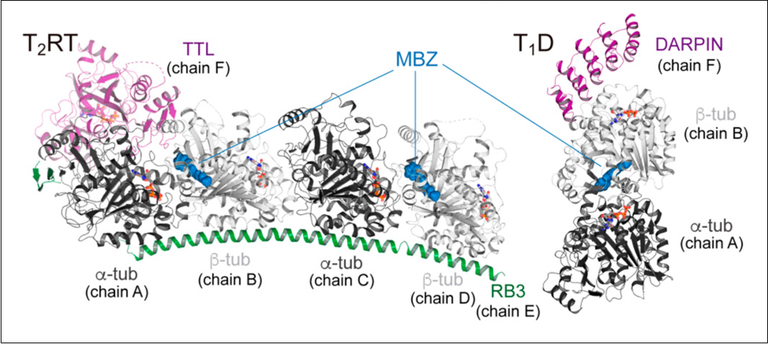Do you want to keep up to date? Subscribe to our newsletter. 1mail every 2months! |
 |

Image obtained at the XALOC beamline of ALBA. Drug mebendazole (MBZ) bounds to the protein that forms the microtubules: tubulin (T2RT and T1D).
Cerdanyola del Vallès, 5th May 2022 Microtubules are intracellular structures that function as true cellular highways for the transport of substances, vesicles, organelles and even viruses, in the case that a cell gets infected. In most viral infections, they are the transport routes to generate the viral factories, regions close to the nucleus where virus production is concentrated.
The idea is to design drugs that, by binding to microtubules, prevent viruses from using them during the infection process. In general, drugs that target microtubules are called MTAs (microtubule targeting agents). There are two types: stabilizers (MSA) and destabilizers (MDA). Both are widely available and most of these drugs are in the WHO Essential Medicines List, and hence, they are therapeutic alternatives that are affordable and available worldwide.
Researchers from CIB Margarita Salas selected 16 commercially available MTA (including 15 in clinical use) to analyse their capacity to inhibit the viral replication against 5 different virus: the human common cold coronavirus (HCoV), the pandemic SARS-CoV-2 coronavirus, the vesicular stomatitis virus, the poxvirus vaccinia and African swine fever virus.
Scientist confirmed that the MTA tested had an effect on virus replication and spreading and that this effect varies according to the virus dependency on the microtubular network. “The inhibitory effect obtained varied depending on the specific functions that viruses have developed throughout evolution to exploit cellular transport machinery”, explains Dra. Marian Oliva, researcher at CIB Margarita Salas-CSIC.
In particular, the most complex use of microtubules filaments might correspond to coronavirus (CoVs), such as the one responsible for the Covid-19 pandemic. Microtubules are necessary both for virus internalization and later at several levels of the formation of the viral replication site. In fact, S and M coronavirus proteins (located on the virus surface) interact with tubulin (protein that forms microtubules) during the infection, although their specific function is currently unknown. Various projects involving the use of the ALBA Synchrotron are under way to study deeper these aspects.
“We confirmed our initial hypothesis: microtubules are a promising target for the development of broad-spectrum antivirals. In addition, and considering the wide variety of effects depending on the virus model, new screening tools should be developed to determine which are the most suitable MTAs according to specific viral infections.”, adds Dra. Oliva.
The research team also concludes that MDAs are more effective than MSAs in disrupting cytosolic trafficking and viral infection. Indeed, an MDA called colchicine has been used during the Covid-19 pandemic to treat the acute respiratory distress syndrome, given its known anti-inflammatory effect.
Proteins and drugs under the synchrotron light
Last but not least, another prove of the MTAs antiviral effect was obtained at the XALOC beamline of the ALBA Synchrotron. Thanks to the X-rays diffraction technique available at XALOC, a high-resolution three-dimensional image of the structure of molecules is obtained. In this case, the CIB Margarita Salas-CSIC team brought a sample of mammalian tubulin bounded to the drug mebendazole, one of the most efficient MTAs and taken as a representative of the benzimidazole group.
This protein-drug complex was illuminated with synchrotron X-rays; and researchers unveiled where exactly mebendazole binds in the tubulin, after analysing all the data and the 3D image obtained. Specifically, mebendazole binding site is at the colchicine domain. The drug blocks the tubulin and prevents forming the microtubule. "Synchrotron light analysis has allowed us to know the underlying molecular mechanism of the drug, which contributes to the future development of specific drugs for the most efficient tubulin binding site," explains Dr. Oliva.
Combining these different studies, the research group from CIB Margarita Salas has demonstrated the role of MTAs in viral infections, highlighting their activity as broad-spectrum antivirals, including against SARS-CoV-2 infection. Dr. Fernando Díaz clarifies that “given the variety of processes in which viruses are able to hijack the microtubule network cytoskeleton, the effect of MTAs varied depending on the model virus, the cell type, and the stages of infection analysed. However, all of them presented antiviral effect to some degree, further confirming that microtubules are a key target for antiviral therapy.”
Reference: María Ángela Oliva, Carlota Tosat-Bitrián, Lucía Barrado-Gil, Francesca Bonato, Inmaculada Galindo, Urtzi Garaigorta, Beatriz Álvarez-Bernad, Rebeca París-Ogáyar, Daniel Lucena-Agell, Juan Francisco Giménez-Abián, Isabel García-Dorival, Jesús Urquiza, Pablo Gastaminza, José Fernando Díaz, Valle Palomo and Covadonga Alonso. Effect of Clinically Used Microtubule Targeting Drugs on Viral Infection and Transport Function. Int. J. Mol. Sci. 2022, 23(7), 3448; https://doi.org/10.3390/ijms23073448
With the collaboration of Fundación Española para la Ciencia y la Tecnología. The ALBA Synchrotron is part of the of the Unidades de Cultura Científica y de la Innovación (UCC+i) of the FECYT and has received support through the FCT-20-15798 project.





